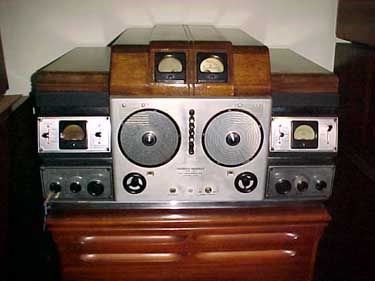While I've been inhaling rosin fumes from my forays into radio repair, I've also been doing my wintertime reading of old radio and electronics magazines.
I still believe I was born 40 years late; I would love to have been a young man in the heyday of radio, the 1930s! I love reading the articles and pouring over the how-to-build articles (the problem today is that then-common parts, like grid-leak resisters, are no longer easily located).
I also have a love affair with 1930s and 1940s receivers. While they mostly were fairly crude compared to today's offerings, I still enjoy them.
The oldest Hallicrafters receiver I've owned though is still 1940s model, though barely — the S-20R. The S-20R was a revision of the earlier S-20 shortwave receiver … in the 1930s, its receivers used metal dials that were external and attached to the front of the receiver. By the end of that decade, they moved to plastic dial faces internallly mounted, which made for a much nicer looking receiver. The S-20R was such an update to the earlier S-20.
As with lots of the old shortwave sets, the S-20R was fairly deaf above 20 MHz. The other problem was with the dial graduations on those upper frequencies, which made fine tuning difficult on AM and damn near impossible on CW.

But the 1930s receiver by Hallicrafters that I would love to own is the Skyrider Diversity, pictured at right, which was basically two receivers in one cabinet.
For a time in the 1930s, diversity reception was all the rage. It was a technique used to reduce or eliminate fading of shortwave signals by using a second receiver and antenna, and combining the signals with the first receiver, the theory was that the phase difference between the signals would allow one to fill the “low” signals of the other.
Commercial interests had found successful applications for diversity reception, and considerable hobbyist magazine space was devoted to it. In fact, in the 1939 radio magazine I'm reading now, Hallicrafters is promoting its top-of-the-line Diversity receiver, which had been introduced less than a year earlier. The magazine also has an interesting article by McMurdo Silver detailing how to build a diversity receiving device that uses the input from two antennas feeding a single receiver. This device was heralded as the answer that would allow every radio hobbyist to afford diversity reception (the Halli Diversity receiver was accompanied by a top-of-the-line price!).
But beyond the experiments of hobbyists, I don't know that diversity reception really caught on among regular radio listeners. Everyone wanted — and needed — a radio, so the great many who bought radios were happy to settle for the All American Five of their favorite make.
I know the 30s were the heyday of radio, but if you look at the postwar years, THAT was the true period of the ascent of Hallicrafters. Buoyed by the war years, they immediately went into production of consumer goods for the home market. The S-38 receiver and its variants was their first new postwar receiver. It was cheap to build and cheap to buy.
I don't expect Santa to bring me a Skyrider Diversity receiver (or any Hallicrafter receivers); the truth is I have receivers around here to repair and use. I still have an SX-101A and a National NC-300 boxed up to evaluate (the boxes don't clank or rattle, so I'm hopeful, LOL!).
-30-
